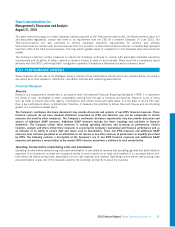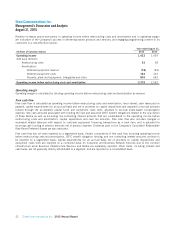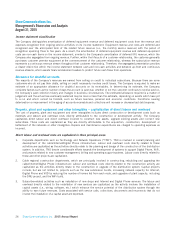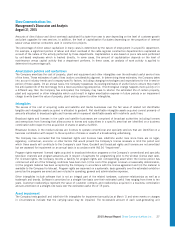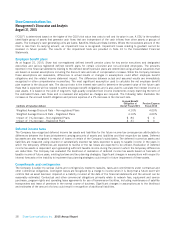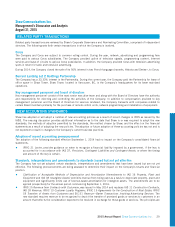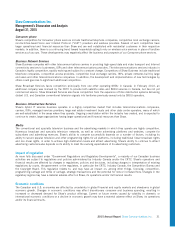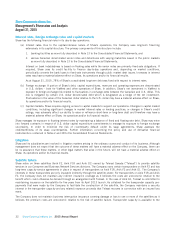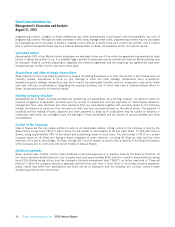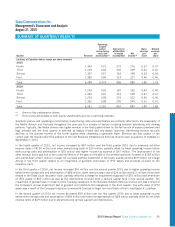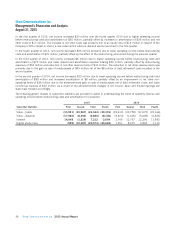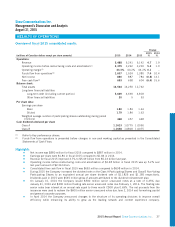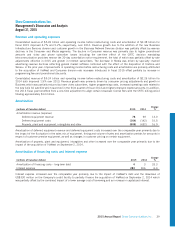Shaw 2015 Annual Report Download - page 33
Download and view the complete annual report
Please find page 33 of the 2015 Shaw annual report below. You can navigate through the pages in the report by either clicking on the pages listed below, or by using the keyword search tool below to find specific information within the annual report.
Shaw Communications Inc.
Management’s Discussion and Analysis
August 31, 2015
Consumer phone
Shaw’s competitors for Consumer phone services include traditional telephone companies, competitive local exchange carriers,
non-facilities-based Voice over Internet Protocol (“VoIP”) providers and wireless providers. Several of such competitors have
larger operational and financial resources than Shaw and are well established with residential customers in their respective
markets. In addition, there is a continuing trend toward households opting to rely on wireless voice services in place of landline
services such as ours. These developments may negatively affect the business and prospects of our Consumer phone services.
Business Network Services
Shaw Business competes with other telecommunications carriers in providing high-speed data and video transport and Internet
connectivity services to businesses, ISPs and other telecommunications providers. The telecommunications services industry in
Canada is highly competitive, rapidly evolving and subject to constant change. Competitors of Shaw Business include traditional
telephone companies, competitive access providers, competitive local exchange carriers, ISPs, private networks built by large
end users and other telecommunications companies. In addition, the development and implementation of new technologies by
others could give rise to significant additional competition.
Shaw Broadcast Services faces competition principally from one other operating SRDU in Canada. In February 2010, an
additional company was licensed by the CRTC to provide both satellite video and SRDU services in Canada, but has not yet
commenced service. Shaw Broadcast Services also faces competition from the expansion of fibre distribution systems delivering
distant U.S. and Canadian conventional television signals into territories previously served only by SRDU operators.
Business Infrastructure Services
Shaw’s hybrid IT services business operates in a highly competitive market that includes telecommunications companies,
carriers, ISPs, managed services providers, large real estate investment trusts and other data centre operators, many of which
are well-established in the areas where they operate. Ongoing consolidation within the industry has created, and is expected to
continue to create, large organizations having larger operational and financial resources than Shaw.
Media
The conventional and specialty television business and the advertising markets in which they operate are highly competitive.
Numerous broadcast and specialty television networks, as well as online advertising platforms and websites, compete for
subscribers and advertising revenues. Shaw’s ability to compete successfully depends on a number of factors, including its
ability to secure popular television and other programming rights for all platforms, including traditional linear broadcast rights
and non-linear rights, in order to achieve high distribution levels and attract advertising. Shaw’s ability to continue to attract
advertising customers also depends on its ability to meet the evolving expectations of its advertising customers.
Impact of regulation
As more fully discussed under “Government Regulations and Regulatory Developments”, a majority of our Canadian business
activities are subject to regulations and policies administered by Industry Canada and/or the CRTC. Shaw’s operations and
financial results are affected by changes in regulations, policies and decisions, including changes in interpretation of existing
regulations by courts, the government or the regulators, in particular the CRTC, Industry Canada, the Competition Bureau and
the Copyright Board. This regulation relates to, and may have an impact on, among other things, licensing, competition,
programming carriage and terms of carriage, strategic transactions and the potential for new or increased fees. Changes in the
regulatory regime may have a material adverse effect on Shaw, its operations and/or its financial results.
Economic conditions
The Canadian and U.S. economies are affected by uncertainty in global financial and equity markets and slowdowns in global
economic growth. Changes in economic conditions may affect discretionary consumer and business spending, resulting in
increased or decreased demand for Shaw’s product offerings. Current or future events caused by volatility in domestic or
international economic conditions or a decline in economic growth may have a material adverse effect on Shaw, its operations
and/or its financial results.
2015 Annual Report Shaw Communications Inc. 31


